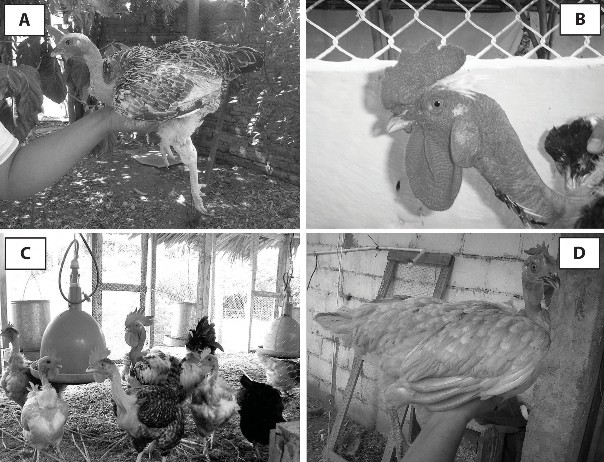Morphometric characterization of chickens naked neck Gallus domesticus nudecullis in the ch'ortí, region, Guatemala
DOI:
https://doi.org/10.36829/63CTS.v2i1.42Keywords:
Hen morphology, zoometriy, local zoogenetics resourcesAbstract
Hens and roosters naked neck (324 females and 60 males) were characterized morphological and phenotypically in four villages of the ch’ortí area in the province of Chiquimula. Variables evaluated were 18 quantitative for females and 16 for males, nine qualitative and eight zoometrics ranges. The zoometric variables analyzed were made according to the univariate analysis procedure with measurements of central tendency and dispersion measurements to analyze the proportion and harmony between the different corporeal areas we used the Pearson correlation. In the results weight of 1.84 kg/female and 2.29 kg/male; raised 27.84 cm/female and 32.51cm/male; metatarsal 10.25 cm/female and 11.76 cm/male; the hen has more height than length, raised in the front, concerning to the perimeters, the abdominal is the biggest and curved, which is characteristic in lay eggs hens with flat dorsal. Corporeal indices, they are elongated birds, reproductive capability (pelvic index 71.82%) and less muscles developed to produce meat as food for humans (compactness index 6.80% female and 7.03% male), elongated head, elliptical thorax and long and strong extremities. Phenotypically and morphologically characteristics describe a bird with white skin, yellow metatarsus, feathering on the throat, simple crest, chin and earlobes, the feathering colors are a combination of brown, black, grey, and white, and the colors of the egg shell are from white to light brown, and also has a good corporal harmony up to 61%, which brings an acceptable mild homogeneity comparable to the structure of a hen.Downloads
References
Álvarez, X. (2010). Genética del color de la gallina Piñeira. La Coruña, España: Fundación para o Avance Científico da Veterinaria en Galicia. Re- cuperado de www.agalpi.org/publicaciones/geneticacolor.htm
Araujo, J. (2004). Características zoométricas de va- cas de la raza Miñota. Trabajo presentado en el IV Congreso Ibérico sobre Recursos Genéticos Animales. Ponte da Lima, Brasil.
Campo, J. (2009). Valoración morfológica de las galli- nas. En C. Sañudo (Ed.), Valoración morfológica de los animales domésticos (pp. 589-612). Madrid: Ministerio de Medio Ambiente y Medio Rural y Marino.
Campo, J. (2010). Razas Españolas de Gallinas. Ma- drid: Instituto Nacional de Investigación y Tec- nología Agraria y Alimentaria.
Faruque, S., Siddiquee, N., Afroz, M., & Islam, M. (2010). Phenotypic characterization of native chicken reared under intensive management system. Journal ot the Bangladesh Agricultural University, 8(1), 79-82. https://doi.org/10.3329/jbau.v8i1.6402
Guéye, E., Ndiaye, A., & Branckaert, D. (1998). Prediction of body on the basis of body measurements in mature chickens in Senegal. Livestock Research for Rural Development, 10(3), 21.
Méndez, Y., (2010). Zoometría comparada en las galli- nas Baleares (Tesis de maestría). Universidad de Córdoba, España. Recuperado de www.uco.es/zootecniaygestion/img/pictorex/08_12_51_F[1]
Mou, C., Pitel, F., Gourichon, D., Vignoles, F., Tzi- ka, A., Tato, P., … Headon, D. J. (2011). Cryptic patterning of avian skin confers a developmental facility for loss of neck feathering. PLoS Biology, 9(3), e10011028. doi: 10.1371/Journd. pbio.1001028
Parés i Casanova, P. M. (2009). Zoometría. En C. Sañudo (Ed.) Valoración morfológica de los animales domésticos (pp. 184-193). Madrid: Ministerio de Medio Ambiente y Medio Rural y Marino.
Pérez, A., Polanco, G., & Pérez, Y. (2004). Algunas características morfológicas del exterior de la gallina local de la región central de la provincia de Villa Clara, Cuba. Livestock Research for Rural Development, 16(10), 76.
Pitel, F., Berg, R., Coquerelle, G., Crooijmans, R., Groenen, M., Vignal, A., & Tixier-boichard, M. (2000). Mapping the Naked Neck (NA) and Poly- dactyly (PO) mutants of the chicken with microsatellite molecular markers. Genetics Selection Evolution, 32, 73-86. https://doi.org/10.1186/1297-9686-32-1-73
Raij, A. O, Igwebuike, J., & Usman, M. (2009). Zoometrical body measurements and their relation with weight in matured local muscovy ducks in Borno state Nigeria. Journal of Agricultural and Biological Science, 4(3), 58-62.
Suchini, C. A. (2009). Evaluación de tres dietas para gallina criolla cuello desnudo y su efecto sobre los parámetros productivos y reproductivos en su etapa final de postura bajo un sistema semiintensivo (Tesis de licenciatura). Centro Universitario de Oriente, Universidad de San Carlos de Guate- mala, Chiquimula, Guatemala.
Valencia, N. F. (2011). La Gallina Criolla Colombiana. Palmira: Universidad Nacional de Colombia sede Palmira.
Valle, J. (2007). Caracterización de la gallina de cuello desnudo en la Región Chortí Chiquimula (Tesis de licenciatura). Centro Universitario de Oriente, Universidad de San Carlos de Guatemala, Chiquimula, Guatemala.
Zaragoza, M., Rodríguez, H., Hernández, Z., Perezgrovas, G., Martínez, C., & Méndez, E. (2013). Caracterización de gallinas batsi alak en las tierras altas del sureste de México. Archivos de Zootecnia, 62(239), 321-332.

Downloads
Published
How to Cite
Issue
Section
License
Copyright (c) 2015 Ciencia, Tecnología y Salud

This work is licensed under a Creative Commons Attribution-NonCommercial-ShareAlike 4.0 International License.
El autor que publique en esta revista acepta las siguientes condiciones:
- El autor otorga a la Dirección General de Investigación el derecho de editar, reproducir, publicar y difundir el manuscrito en forma impresa o electrónica en la revista Ciencia, Tecnología y Salud.
- La Direción General de Investigación otorgará a la obra una licencia Creative Commons Atribución-NoComercial-CompartirIgual 4.0 Internacional









